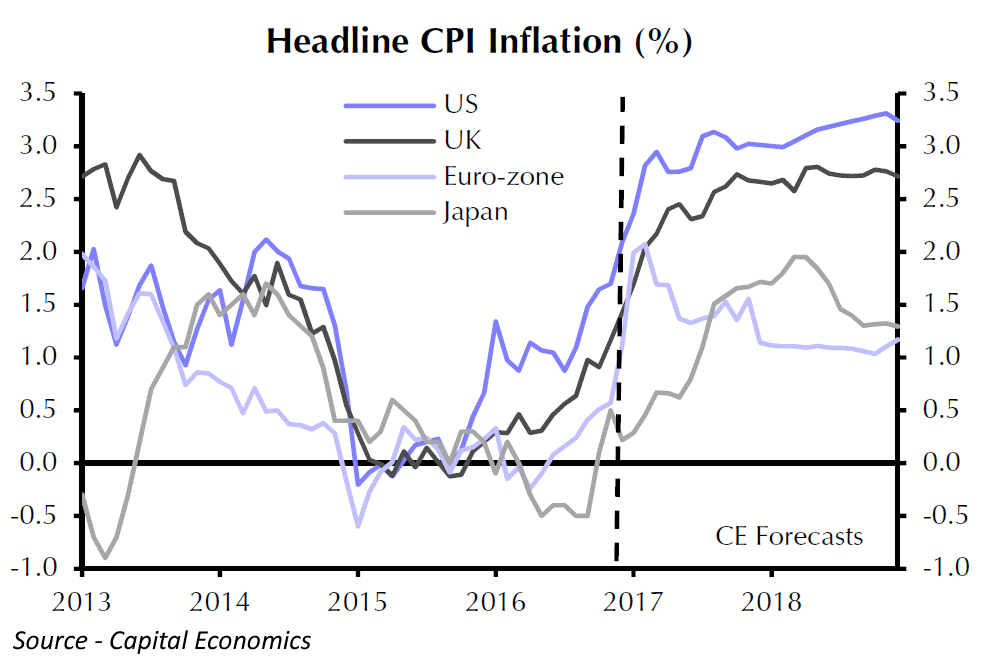Economic Overview
For the first ten months of the year, financial markets were jittery due to fears of recession, deflation, and overstretched valuations. Also top of mind were concerns over the effects of a slowing China and the impact of a long-overdue Fed rate hike. These fears caused two market pullbacks that held the world index to low single digits – on life support from global central bank promises of continued accommodative monetary policy. All the meanwhile though, economic data started to stabilize and could even be said to accelerate in the U.S. The pivotal moment for the markets was the surprising Trump election and Republican capture of both legislatures – catapulting U.S. equity indices to new highs.
If one were to reminisce, the fourth quarter of 2016 should be remembered as the hallmark of regime change on many fronts. Central bankers are now singing a different tune, conceding the limits of easy money and necessity of fiscal policy. No longer is there talk of a GDP growth stall and deflation risk; especially in the U.S. where the chatter now is all about growth and inflation. In the wake of a watershed moment in American politics, improving corporate profitability and the promise of fiscal stimulus helped usher in a new confidence in equites during the last two trading months of the year. The Fed rate hike, long dreaded, was finally realized – the ensuing carnage in the bond market relegated to a side-show with a minimal impact on other markets.

The global political environment has also shifted, possibly taking a turn for the worse. The implementation of the Brexit, a Trump White House, and European populist movements all point to a world that is growing more nationalistic and protectionist – something that could hinder long-term economic growth.
Fixed Income Markets
After a full year from the last rate hike, the U.S. Fed finally found a perfect moment in December to raise the funds rate by a quarter of point to 0.75%. Moreover, it also increased the number of hikes it expects for 2017 from two to three. The increasingly hawkish tone reflects reality of an improved macroeconomic backdrop. Wage growth is accelerating and the economy is approaching full employment. While the fundamentals for a return to moderate inflation have been in place for some time, the prospect of fiscal stimulus from the Trump administration has exacerbated the outlook.
Fixed income markets were routed last quarter with longer dated maturities enduring double-digit losses shortly after the election results. The Canadian and U.S. broad-based bond indices declined 3.4% and 3.0% respectively in the past 90 days but were up 1.6% and 2.6% for the year. While the prospect of increased fiscal deficits, trade barriers and reduced immigration are inflationary, a higher U.S. dollar and the current high level of savings by consumers may temper these elevated expectations. What’s more, the drastic uptick in yields are expected to stabilize yields as this asset class attracts capital from abroad where rates are at historic lows and from domestic investors who increasingly view the new yields favourably.
Bond markets are expected to experience some resistance to the recent upward pressure on yields. With the developed world having aging populations, increased savings rates, and bloated government balance sheets, plenty of countervailing forces exist to temper inflation. Finally, many of the large-scale spending plans and regulatory reforms will take years to implement and could also disappoint investor’s currently sky high expectations along the way.
Equity Markets
| 31-Dec-16 | Q4-2016 | 1Y | 3Y | 5Y | 10Y |
Canada |
|||||
| Major Canadian Indices ($CA) | |||||
| S&P/TSX Composite | 4.54% | 21.08% | 7.06% | 8.25% | 4.72% |
| S&P/TSX 60 | 5.59% | 21.36% | 7.92% | 8.99% | 4.86% |
| S&P/TSX Capped Cdn. Sector ETF Indices ($CA) | |||||
| Cdn. Energy | 11.11% | 39.64% | -3.94% | -0.90% | -0.83% |
| Cdn. Materials | -6.21% | 41.20% | 2.79% | -6.19% | 0.04% |
| Cdn. Industrials | 5.19% | 24.69% | 8.93% | 15.56% | 9.73% |
| Cdn. Consumer Discretionary | 1.53% | 10.69% | 12.09% | 19.71% | 7.30% |
| Cdn. Consumer Staples | -1.20% | 9.06% | 21.69% | 22.24% | 12.12% |
| Cdn. Health Care | -13.36% | -43.26% | -5.16% | 7.13% | 6.25% |
| Cdn. Financials | 11.54% | 24.15% | 10.67% | 15.02% | 6.91% |
| Cdn. Information Technology | -0.60% | 4.36% | 17.88% | 19.03% | 5.63% |
| Cdn. Telecommunication Services | -2.15% | 18.29% | 12.78% | 12.32% | 10.15% |
| Cdn. Utilities | -0.44% | 17.60% | 9.62% | 5.53% | 5.67% |
| Cdn. Real Estate | 0.12% | 10.75% | 11.88% | 11.76% | 6.75% |
| Global Gold | -18.03% | 50.95% | 8.53% | -10.53% | -4.09% |
| Global Mining | -2.92% | 44.44% | -2.18% | -5.43% | – |
U.S. |
|||||
| Major U.S. Indices – S&P ($CA) | |||||
| S&P 500 (LargeCap) | 6.28% | 8.61% | 17.66% | 21.21% | 8.47% |
| Russell 2000 | 11.41% | 17.68% | 15.36% | 21.00% | 8.59% |
| International & Other | |||||
| Exchange Indices ($CA) | |||||
World |
4.38% | 4.91% | 12.81% | 17.39% | 5.90% |
Europe |
2.00% | -2.78% | 5.23% | 12.98% | 2.40% |
Japan |
2.22% | -0.35% | 11.12% | 14.64% | 2.17% |
Pacific ex-Japan |
-0.38% | 4.76% | 7.58% | 11.40% | 5.72% |
EAFE (Europe, Australasia, Far East) |
1.67% | -1.53% | 6.83% | 13.13% | 2.66% |
EM (Emerging Markets) |
-1.82% | 8.26% | 5.71% | 7.45% | 3.63% |
Equity markets started the month tentatively as investors fretted about the U.S. election and the Fed’s hawkish tone. European markets were stalled on the continued prospect of a hard Brexit along with the ECB’s acknowledgement that quantitative easing would eventually have to end. Investors also proved skittish on resurfacing news of the Clinton email scandal and the resulting Trump surge in the polls. Markets initially plunged on President-elect Trump’s surprise win, but investors soon had a change of heart about the economy’s prospects under his tenure. Adding to the optimism was OPEC’s surprising agreement on production cuts, which is thought to stabilize the price of oil at a “goldilocks” level of $45 – $60 per barrel, low enough to support consumer spending but high enough for marginal producers. Despite a 47% increase from its February 2016 low, OPEC’s recent track record coupled with a greater incentive for more U.S. shale production make it premature to say whether oil prices have stabilized.
After a slow downward slide in October, equity markets snapped back to life in November – a rally that was punctuated by a Trump victory and drastic change in sentiment. U.S. equites were the main beneficiary of the “Trump trade”, especially small-cap companies who are expected to benefit from lower corporate tax rates and less regulation. Likewise, financial stocks benefited to the same news in addition to the prospect of rising interest rates. In the end, what initially vexed investors proved to be taken as positive events – sending most major U.S indices to record highs. With the tailwind of a 2.3% fall to the Canadian dollar, the world index was up 4.3%, led by U.S. small-cap (+11.4%), U.S. large-cap (+6.2%), Europe (+2%) and Japan. (+2.2).
Canada’s TSX also had a strong showing (+4.5%) – but with quite a bit of sector variation over the quarter. Negative contributors for the second consecutive quarter were Gold (-18%), Health Care (-13%) and Materials (-6%). Energy and Financials both contributed significantly at over +11% – respectively benefiting from the oil price rebound and rise in interest rates. Canada’s economy has rebounded from significant initial weakness, but growth in 2016 is targeted at only 1.4%. The pace of expansion is expected to pick up slightly in 2017 on the coat-tails of the U.S. expansion and a relatively weak loonie. However, with the rise in longer term interest rates and recent changes to federal mortgage rules, Canada’s housing market is expected to moderate in 2017 and not be a major factor in GDP growth.
Portfolio Positioning
Amidst stabilizing economic data, moderate inflation and improving corporate profitability, risk assets are still expected to outperform bonds. Despite the recent rapid rise in yields, more downside risk remains for fixed-income. As such, we are adhering current asset mix targets – remaining at the higher end of our allocation to equities. As yields climb and the curve steepens, we will reconsider a shift away from our significant underweight position in bonds. Notwithstanding our outlook, an allocation to investment-grade fixed income securities within a strategic framework is essential to all client portfolios as a buffer to the downside that will inevitably visit upon equity markets from time to time.






